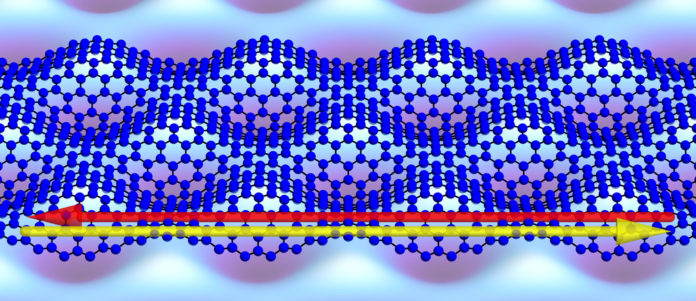In more recent years, twisted bilayer graphene has shown to have superconductivity. It is an ideal material for investigations of strongly correlated phenomena, which could lead to insights into the physics of high-critical-temperature superconductors and quantum spin liquids.
However, because of the low yield of manufacturing twisted bilayer graphene, applying this method to manufacture devices remains difficult.
A new study could lead to the development of quantum devices such as orbital magnets and superconductors in the future, thanks to a better understanding of how unique features emerge when single sheets of graphene are subjected to periodic strain. Scientists have demonstrated how patterned, periodic deformations of a single layer of graphene can change it into a material with electronic properties similar to twisted graphene bilayers.
Using single layers of graphene placed onto a carefully-patterned substrate, called a “bed of nails,” is one alternative to the complex twisted bilayer method. The method applies an external force, or strain, periodically.
Scientists started with understanding the movement of electrons in this single-layered system to better comprehend the quantum geometrical properties of this system.
They ran several computer simulations of single-layered experiments. To their surprise, the simulations revealed new evidence of unexpected phenomena along the surface of the material but only along one side.
Professor Eugene Mele in Penn’s Department of Physics & Astronomy in the School of Arts & Sciences said, “Generally, topology in the bulk associates with surface properties, and when that’s the case, all surfaces inherit the property. Here, the fact that there were edge modes on one side and not the other struck me as being deeply unusual.”
Graduate student Võ Tiến Phong said, “This finding was unexpected because in this system, the average pseudo-magnetic field, induced when the system is strained, was zero—positive in one area but negative in the other, which the researchers hypothesized would cancel out any unique phenomena. If the magnetic field is zero, you probably won’t get any interesting physics. On the contrary, we found that even though the average magnetic field is zero, it still gives you some interesting physics at the edge.”
To explain the unexpected result, scientists carefully observed a similar experimental system. In that setup, single sheets of graphene are bent to simulate a constant instead of a periodic strain-induced field. This system had the same topological index. It means the edge states that only thrive on a specific side of the material would also occur.
Overall, this study predicts that flat bands, similar to the ones found in twisted bilayer graphene, are created by depositing an atomically thin single layer onto a bed-of-nails substrate that induces a periodic distortion on the graphene sheet.
Phong said, “Although the physics is simple, meaning that you can get the system to behave the way you want in a more controlled way, the phenomenology that you can get out of it is not. It’s very rich, and we’re still uncovering new things as we speak.”
“And because these single-layer systems are simpler to work with, this enhanced theoretical understanding has the potential to aid in future discoveries in the field of edge state physics, including possible new devices such as ultra-small, incredibly fast quantum materials.”
Journal Reference:
- Võ Tiến Phong and E. J. Mele. Boundary Modes from Periodic Magnetic and Pseudomagnetic Fields in Graphene. DOI: 10.1103/PhysRevLett.128.176406
